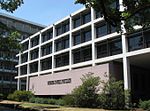WEHI
WEHI (English: ), previously known as the Walter and Eliza Hall Institute of Medical Research, and as the Walter and Eliza Hall Institute, is Australia's oldest medical research institute. Sir Frank Macfarlane Burnet, who won the Nobel Prize in 1960 for his work in immunology, was director from 1944 to 1965. Burnet developed the ideas of clonal selection and acquired immune tolerance. Later, Professor Donald Metcalf discovered and characterised colony-stimulating factors. As of 2015, the institute hosted more than 750 researchers who work to understand, prevent and treat diseases including blood, breast and ovarian cancers; inflammatory diseases (autoimmunity) such as rheumatoid arthritis, type 1 diabetes and coeliac disease; and infectious diseases such as malaria, HIV and hepatitis B and C.Located in Parkville, Melbourne, it is closely associated with The University of Melbourne and The Royal Melbourne Hospital. The institute also has a campus at La Trobe University. The Director of WEHI, since July 2009, is Professor Doug Hilton , a molecular biologist.
Excerpt from the Wikipedia article WEHI (License: CC BY-SA 3.0, Authors).WEHI
Story Street, Melbourne Parkville
Geographical coordinates (GPS) Address External links Nearby Places Show on map
Geographical coordinates (GPS)
| Latitude | Longitude |
|---|---|
| N -37.798 ° | E 144.956 ° |
Address
Walter and Eliza Hall Institute
Story Street
3050 Melbourne, Parkville
Victoria, Australia
Open on Google Maps





